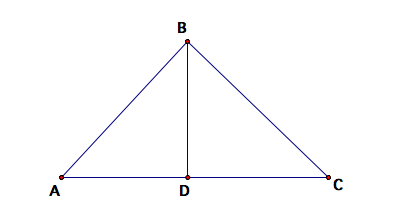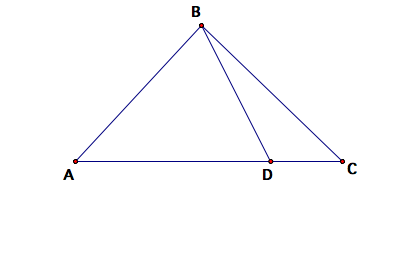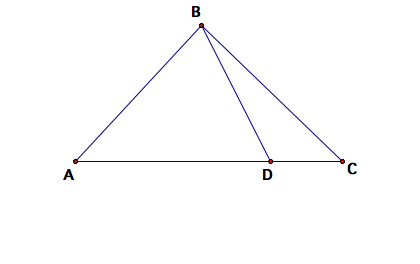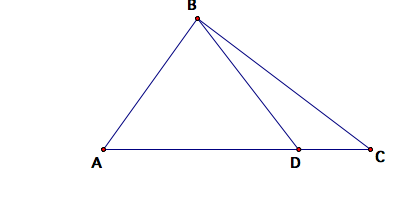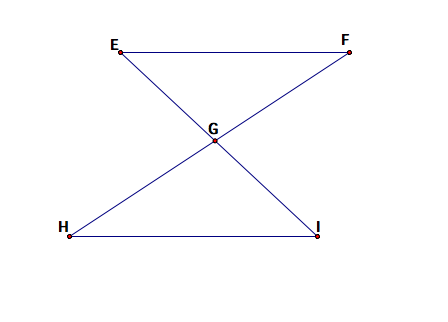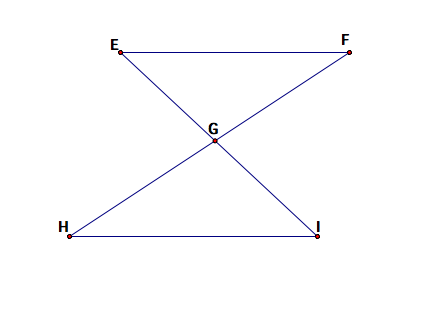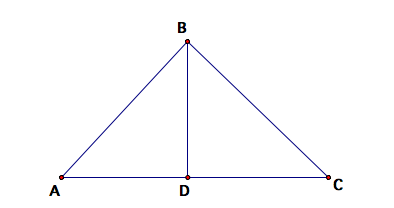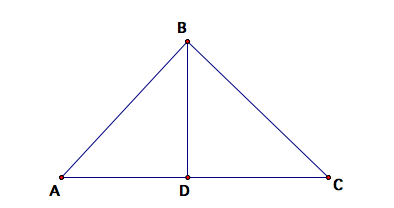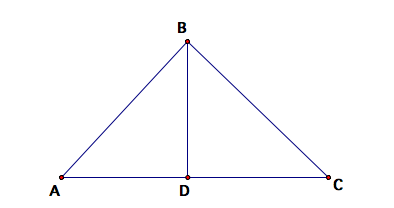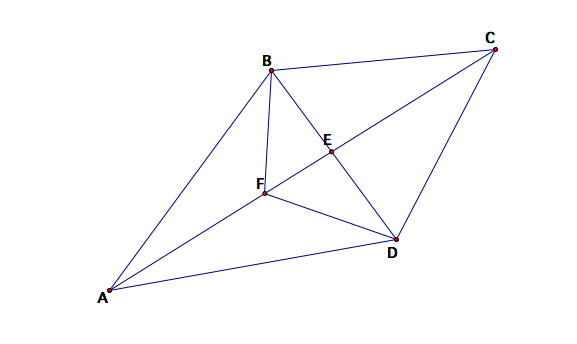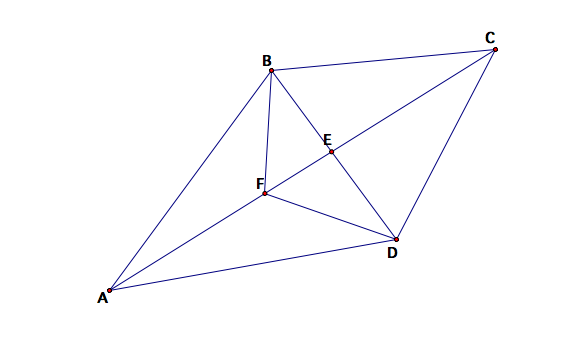Midterm Review - Definitions, Theorems And Postulates
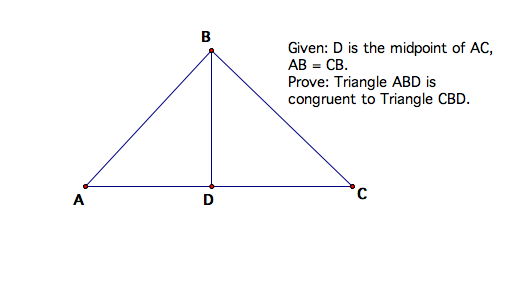
Geometry Review of 1st semester
- 1.
Which congruency theorem/postulate proves that the triangles are congruent?
- A.
ASA
- B.
SAS or SSS
- C.
Not possible
Correct Answer
B. SAS or SSSExplanation
You can get angle A = Angle C for SAS, or you can use BD = BD for SSSRate this question:
-
- 2.
Name the reason for the following conclusion.If AC is perpendicular to BD, why is angle ADB = to angle CDB?
- A.
Perpendicular lines form right angles
- B.
Perpendicular lines form congruent angles.
- C.
Angles ADB and CDB form a linear pair
- D.
Angles ADB and CDB are supplementary
Correct Answer
B. Perpendicular lines form congruent angles.Explanation
While all the above reasons are valid, the second one is the most direct. You could also say perpendicular lines form right angles and then all right angles are equal.Rate this question:
-
- 3.
Why is angle ABC > angle ABD?
- A.
Whole > Part
- B.
GAGS
- C.
Transitive Property
- D.
Exterior Angle > Remote Interior angle
- E.
Triangle Inequality Theorem
Correct Answer
A. Whole > PartExplanation
The given answer "Whole > Part" suggests that angle ABC is greater than angle ABD because in a triangle, the whole angle (angle ABC) is always greater than any of its parts or interior angles (angle ABD). This is a basic concept in geometry where the sum of the interior angles of a triangle is always 180 degrees. Therefore, angle ABC, being a part of the triangle, must be less than 180 degrees and greater than angle ABD.Rate this question:
-
- 4.
Why is angle CDB > Angle A?
- A.
Whole > Part
- B.
GAGS
- C.
Transitive Property
- D.
Exterior Angle > Remote Interior Angle
- E.
Triangle Inequality Theorem
Correct Answer
D. Exterior Angle > Remote Interior AngleExplanation
The given answer suggests that the reason angle CDB is greater than angle A is because of the property that an exterior angle of a triangle is always greater than its corresponding remote interior angle. In this case, angle CDB is an exterior angle of triangle CDB, while angle A is a remote interior angle of triangle CDB. Therefore, angle CDB must be greater than angle A.Rate this question:
-
- 5.
What series of reasons will give you DBC < BDC if you are given ABD > DBC?
- A.
GAGS, Exterior Angle Theorem
- B.
Exterior Angle Theorem, Transitive Property
- C.
Triangle Inequality Theorem, Substitution
Correct Answer
B. Exterior Angle Theorem, Transitive PropertyExplanation
If we are given ABD > DBC, it means that the angle ABD is greater than the angle DBC. According to the Exterior Angle Theorem, the exterior angle of a triangle is equal to the sum of its two remote interior angles. Therefore, the exterior angle ABD is equal to the sum of angles DBC and BDC. Since ABD is greater than DBC, it implies that the sum of DBC and BDC (which is the exterior angle ABD) is greater than DBC alone. This can be represented as DBC < BDC. The Transitive Property allows us to conclude that if ABD > DBC and DBC < BDC, then ABD > BDC.Rate this question:
-
- 6.
What additional information would need to be given to prove Triangle EGF is congruent to Triangle IGH by ASA if you are given G is the midpoint of HF
- A.
G is also the midpoint of HI
- B.
EF = IH
- C.
Angle F = Angle H
- D.
Angle E = Angle I
- E.
EI is perpendicular to FH
Correct Answer
C. Angle F = Angle HExplanation
Angle E = Angle I gives you AAS, not ASA. Don't miss vertical angles are equal!Rate this question:
-
- 7.
If you are given that G is the midpoint of FH and EI, what reason tells you that Triangle EFG is congruent to Triangle IHG?
- A.
SSS
- B.
ASA
- C.
SAS
Correct Answer
C. SASExplanation
Given that G is the midpoint of FH and EI, we can conclude that FG is congruent to GH and EG is congruent to GI. This is because the midpoint of a line segment divides it into two congruent segments. Additionally, we know that angle EGF is congruent to angle IHG because they are vertical angles. Therefore, we have two pairs of corresponding sides and one pair of corresponding angles that are congruent, satisfying the SAS (Side-Angle-Side) congruence criterion. Hence, Triangle EFG is congruent to Triangle IHG.Rate this question:
-
- 8.
If BD is the perpendicular bisector of side AC, what reason tells you that triangle ADB is congruent to triangle CDB?
- A.
SSS
- B.
ASA
- C.
SAS
Correct Answer
C. SASExplanation
The reason that triangle ADB is congruent to triangle CDB is the SAS (Side-Angle-Side) congruence criterion. This criterion states that if two sides and the included angle of one triangle are congruent to the corresponding sides and included angle of another triangle, then the triangles are congruent. In this case, the sides AD and CD are congruent because BD is the perpendicular bisector of AC, and the included angle at D is congruent because BD is the perpendicular bisector. Therefore, by the SAS criterion, triangle ADB is congruent to triangle CDB.Rate this question:
-
- 9.
If BD is perpendicular to AC and bisects angle ABC, what reason says triangle ADB is congruent to triangle CDB?
- A.
SSS
- B.
ASA
- C.
SAS
Correct Answer
B. ASAExplanation
The given information states that BD is perpendicular to AC and also bisects angle ABC. This means that angle ABD is congruent to angle CBD. Additionally, we know that BD is common to both triangles ADB and CDB. Therefore, we have angle ABD congruent to angle CBD, side BD shared by both triangles, and angle B congruent to itself (reflexive property). These conditions satisfy the ASA (Angle-Side-Angle) congruence criterion, which states that if two angles and the included side of one triangle are congruent to two angles and the included side of another triangle, then the triangles are congruent. Hence, triangle ADB is congruent to triangle CDB.Rate this question:
-
- 10.
If Triangle ABC is isosceles with AB = CB, what angles can you say are congruent by Isosceles Triangle Theorem?
- A.
Angle A = Angle C
- B.
Angle ABD = Angle CBD
- C.
Angle ADB = Angle CDB
Correct Answer
A. Angle A = Angle CExplanation
By the Isosceles Triangle Theorem, if a triangle is isosceles with two sides congruent, then the angles opposite those sides are also congruent. Therefore, in triangle ABC, since AB = CB, we can conclude that Angle A is congruent to Angle C.Rate this question:
-
- 11.
If AF = CE, what reason tells you that AE = CF?
- A.
Whole > Part
- B.
Isosceles Triangle Theorem
- C.
Segment Addition Theorem
- D.
Angle Addition Theorem
- E.
CPCTC
Correct Answer
C. Segment Addition TheoremExplanation
The Segment Addition Theorem states that if three points A, B, and C are collinear and B is between A and C, then AB + BC = AC. In this case, AF = CE implies that AB + BF = AC. Since AE is a part of AC and CF is a part of BF, the Segment Addition Theorem can be applied to conclude that AE + EF = AF, which implies that AE = CF.Rate this question:
-
- 12.
If you were given Triangle AFB congruent to Triangle AFD, what reason would tell you that angle ABF = Angle AD?
- A.
Isosceles Triangle Theorem
- B.
Angle Addition Theorem
- C.
CPCTC
Correct Answer
C. CPCTCExplanation
CPCTC stands for "Corresponding Parts of Congruent Triangles are Congruent." This theorem states that if two triangles are congruent, then their corresponding parts, such as angles and sides, are also congruent. In this case, since Triangle AFB is congruent to Triangle AFD, CPCTC tells us that angle ABF is congruent to angle AD. Therefore, the reason that angle ABF = Angle AD is CPCTC.Rate this question:
-
Quiz Review Timeline +
Our quizzes are rigorously reviewed, monitored and continuously updated by our expert board to maintain accuracy, relevance, and timeliness.
-
Current Version
-
Mar 20, 2023Quiz Edited by
ProProfs Editorial Team -
Dec 04, 2010Quiz Created by
Annacabral
- Algebra Quizzes
- Arithmetic Quizzes
- Calculus Quizzes
- Data Handling Quizzes
- Decimal Quizzes
- Discrete Mathematics Quizzes
- Equation Quizzes
- Fraction Quizzes
- Function Quizzes
- Geometry Quizzes
- Graph Quizzes
- Measurement Quizzes
- Multiplication Quizzes
- Number Quizzes
- Percentage Quizzes
- Place Value Quizzes
- Probability Quizzes
- Problem Solving Quizzes
- Ratio Quizzes
- Shape Quizzes
- Statistics Quizzes
 Back to top
Back to top



